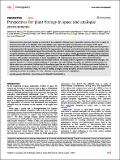Por favor, use este identificador para citar o enlazar a este item:
http://hdl.handle.net/10261/333902COMPARTIR / EXPORTAR:
 SHARE SHARE
 CORE
BASE CORE
BASE
|
|
| Visualizar otros formatos: MARC | Dublin Core | RDF | ORE | MODS | METS | DIDL | DATACITE | |

| Título: | Perspectives for plant biology in space and analogue environments |
Autor: | De Micco, Veronica; Aronne, Giovanna; Caplin, Nicol; Carnero-Díaz, Eugénie; Herranz, Raúl CSIC ORCID CVN ; Horemans, Nele; Legué, V.; Medina, F. Javier CSIC ORCID CVN ; Pereda-Loth, Veronica; Schiefloe, Mona; De Francesco, Sara; Izzo, Luigi Gennaro; Le Disquet, Isabel; Kittang, Ann Iren | Fecha de publicación: | 21-ago-2023 | Editor: | Springer Nature | Citación: | npj Microgravity 9: 67 (2023) | Resumen: | Advancements in plant space biology are required for the realization of human space exploration missions, where the re-supply of resources from Earth is not feasible. Until a few decades ago, space life science was focused on the impact of the space environment on the human body. More recently, the interest in plant space biology has increased because plants are key organisms in Bioregenerative Life Support Systems (BLSS) for the regeneration of resources and fresh food production. Moreover, plants play an important role in psychological support for astronauts. The definition of cultivation requirements for the design, realization, and successful operation of BLSS must consider the effects of space factors on plants. Altered gravitational fields and radiation exposure are the main space factors inducing changes in gene expression, cell proliferation and differentiation, signalling and physiological processes with possible consequences on tissue organization and organogenesis, thus on the whole plant functioning. Interestingly, the changes at the cellular and molecular levels do not always result in organismic or developmental changes. This apparent paradox is a current research challenge. In this paper, the main findings of gravity- and radiation-related research on higher plants are summarized, highlighting the knowledge gaps that are still necessary to fill. Existing experimental facilities to simulate the effect of space factors, as well as requirements for future facilities for possible experiments to achieve fundamental biology goals are considered. Finally, the need for making synergies among disciplines and for establishing global standard operating procedures for analyses and data collection in space experiments is highlighted. | Descripción: | 10 p.-3 fig. 1 tab. | Versión del editor: | https://doi.org/10.1038/s41526-023-00315-x | URI: | http://hdl.handle.net/10261/333902 | DOI: | 10.1038/s41526-023-00315-x | E-ISSN: | 2373-8065 |
| Aparece en las colecciones: | (CIB) Artículos |
Ficheros en este ítem:
| Fichero | Descripción | Tamaño | Formato | |
|---|---|---|---|---|
| npjMicrogravity_De Micco_2023.pdf | Artículo principal | 1,65 MB | Adobe PDF |  Visualizar/Abrir |
CORE Recommender
Page view(s)
41
checked on 30-abr-2024
Download(s)
12
checked on 30-abr-2024
Google ScholarTM
Check
Altmetric
Altmetric
Este item está licenciado bajo una Licencia Creative Commons

